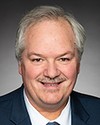Good afternoon. My name is Dr. Adam Kassam. I'm president of the Ontario Medical Association. I am joined by Dr. James Wright, chief of the OMA's economics, policy and research department.
On behalf of Ontario's 43,000 physicians, residents and medical students, thank you for this opportunity to provide the physician perspective on arguably the greatest immediate risk to the viability of health care in Canada, which is the burnout of health care professionals.
Physician burnout is primarily caused by stressors in the workplace including inefficient work processes and environments, and clerical burden. In other words, the inefficiencies and obstacles in the health care system, not caring for patients, are the major contributors to burnout. In fact, the OMA established a burnout task force in 2019. Its objectives were to survey Ontario physicians, residents and medical students to understand the extent of burnout and then to identify specific solutions.
In March 2020, prior to the pandemic, a shocking 29% of Ontario physicians reported high levels of burnout, while another two-thirds reported some level of burnout. By March 2021, one year into the pandemic, that number was even higher, with 35% reporting high levels of burnout and almost three-quarters reporting some level of burnout.
Ontario physicians face years of working above capacity just to clear the pandemic backlog of more than 21 million delayed medical services, let alone reducing the wait times that have plagued the system for decades. Attempting to achieve this within the existing system will only lead to more burnout. Physicians are incredibly dedicated to their patients. However, at some point the stress is untenable, leading some to reduce their workloads, retire prematurely or even leave medicine entirely. This loss of experienced and dedicated physicians will further exacerbate the situation for remaining doctors.
Retention and recruitment of physicians are paramount, given that one million Ontarians currently don't have access to a family doctor. The lack of physicians is even more dire in Canada's north. Today, northern Ontario is experiencing an acute shortage of at least 325 physicians, including family doctors, psychiatrists, anaesthetists and several sub-specialists. Some communities are critically under-serviced.
The OMA's burnout task force has identified the top five system-level actions required to reduce burnout and drive retention and recruitment: first, streamline and reduce required documentation and administrative work; second, ensure fair and equitable compensation for all work done; third, increase work-life balance by making organizational policy changes; fourth, promote the seamless integration of digital health tools into physicians' workflows; finally, provide institutional supports for physician wellness.
These are all system issues. We need to collectively and collaboratively rethink our health care system so that it doesn't contribute to burnout in the first place.
In fact, in Ontario we have developed a plan for solving our system challenges. OMA's “Prescription for Ontario: Doctors' 5-Point Plan for Better Health Care” was released not long ago, in October 2021. It is available at betterhealthcare.ca and it provides a road map of 87 recommendations under five key themes to achieve meaningful and sustainable improvements for the entire health care system in terms of access, equity, efficiency and integration.
As contained in our “Prescription”, the OMA strongly supports the call by Canada's premiers to immediately increase the Canada health transfer from the current 22% to 35% of provincial and territorial health care spending. This will provide the provinces and territories with the resources necessary to make health system improvements within their respective jurisdictions.
Ontario's doctors also recommend other immediate actions by the federal government to reduce burnout and increase retention and recruitment, including, but not limited to, the following. First, incent physicians to practice in the north by offering a federal tax relief of 15%.
Second, fund Canada Health Infoway to develop application programming interfaces, or APIs, to link the electronic medical records systems used within each province. Linking them would allow information to be exchanged among physicians. The lack of interoperability now is one of the most common digital health factors associated with burnout.
Finally, support the development of virtual care appropriateness guidance by the national level specialty societies that would work together to review all procedures within their profession and determine which can appropriately be done virtually and which in person. Supporting the development of such guidelines would reduce decision fatigue for physicians and support equitable, appropriate and high-quality care across the country.
A publicly funded and universally accessible health care system is a cornerstone of Canadian values. On behalf of all Ontario health care professionals, the OMA implores the federal government to provide the tools and resources required by the province to effect sustainable and meaningful change. If we don't fix the health care system, we will never fix burnout. Physicians and other health care professionals are depending on you. Certainly Canadians don't have time to wait.
Thank you. We're happy to answer your questions.




